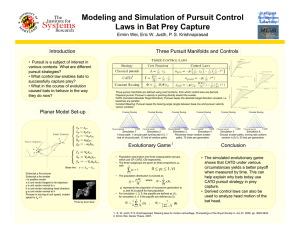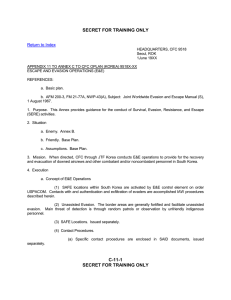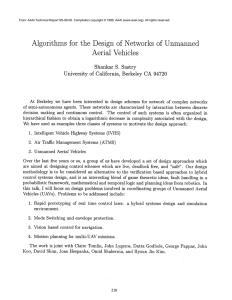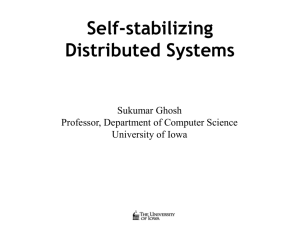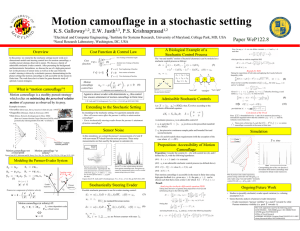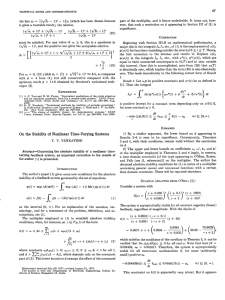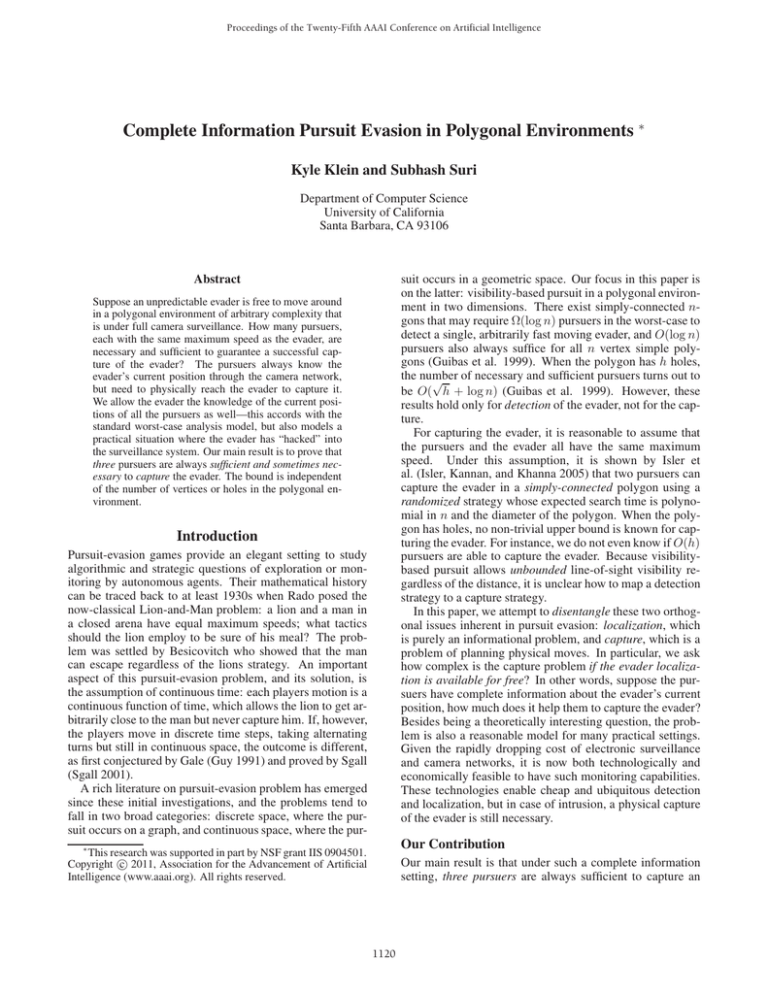
Proceedings of the Twenty-Fifth AAAI Conference on Artificial Intelligence
Complete Information Pursuit Evasion in Polygonal Environments ∗
Kyle Klein and Subhash Suri
Department of Computer Science
University of California
Santa Barbara, CA 93106
suit occurs in a geometric space. Our focus in this paper is
on the latter: visibility-based pursuit in a polygonal environment in two dimensions. There exist simply-connected ngons that may require Ω(log n) pursuers in the worst-case to
detect a single, arbitrarily fast moving evader, and O(log n)
pursuers also always suffice for all n vertex simple polygons (Guibas et al. 1999). When the polygon has h holes,
the number
√ of necessary and sufficient pursuers turns out to
be O( h + log n) (Guibas et al. 1999). However, these
results hold only for detection of the evader, not for the capture.
For capturing the evader, it is reasonable to assume that
the pursuers and the evader all have the same maximum
speed. Under this assumption, it is shown by Isler et
al. (Isler, Kannan, and Khanna 2005) that two pursuers can
capture the evader in a simply-connected polygon using a
randomized strategy whose expected search time is polynomial in n and the diameter of the polygon. When the polygon has holes, no non-trivial upper bound is known for capturing the evader. For instance, we do not even know if O(h)
pursuers are able to capture the evader. Because visibilitybased pursuit allows unbounded line-of-sight visibility regardless of the distance, it is unclear how to map a detection
strategy to a capture strategy.
In this paper, we attempt to disentangle these two orthogonal issues inherent in pursuit evasion: localization, which
is purely an informational problem, and capture, which is a
problem of planning physical moves. In particular, we ask
how complex is the capture problem if the evader localization is available for free? In other words, suppose the pursuers have complete information about the evader’s current
position, how much does it help them to capture the evader?
Besides being a theoretically interesting question, the problem is also a reasonable model for many practical settings.
Given the rapidly dropping cost of electronic surveillance
and camera networks, it is now both technologically and
economically feasible to have such monitoring capabilities.
These technologies enable cheap and ubiquitous detection
and localization, but in case of intrusion, a physical capture
of the evader is still necessary.
Abstract
Suppose an unpredictable evader is free to move around
in a polygonal environment of arbitrary complexity that
is under full camera surveillance. How many pursuers,
each with the same maximum speed as the evader, are
necessary and sufficient to guarantee a successful capture of the evader? The pursuers always know the
evader’s current position through the camera network,
but need to physically reach the evader to capture it.
We allow the evader the knowledge of the current positions of all the pursuers as well—this accords with the
standard worst-case analysis model, but also models a
practical situation where the evader has “hacked” into
the surveillance system. Our main result is to prove that
three pursuers are always sufficient and sometimes necessary to capture the evader. The bound is independent
of the number of vertices or holes in the polygonal environment.
Introduction
Pursuit-evasion games provide an elegant setting to study
algorithmic and strategic questions of exploration or monitoring by autonomous agents. Their mathematical history
can be traced back to at least 1930s when Rado posed the
now-classical Lion-and-Man problem: a lion and a man in
a closed arena have equal maximum speeds; what tactics
should the lion employ to be sure of his meal? The problem was settled by Besicovitch who showed that the man
can escape regardless of the lions strategy. An important
aspect of this pursuit-evasion problem, and its solution, is
the assumption of continuous time: each players motion is a
continuous function of time, which allows the lion to get arbitrarily close to the man but never capture him. If, however,
the players move in discrete time steps, taking alternating
turns but still in continuous space, the outcome is different,
as first conjectured by Gale (Guy 1991) and proved by Sgall
(Sgall 2001).
A rich literature on pursuit-evasion problem has emerged
since these initial investigations, and the problems tend to
fall in two broad categories: discrete space, where the pursuit occurs on a graph, and continuous space, where the pur-
Our Contribution
∗
This research was supported in part by NSF grant IIS 0904501.
c 2011, Association for the Advancement of Artificial
Copyright Intelligence (www.aaai.org). All rights reserved.
Our main result is that under such a complete information
setting, three pursuers are always sufficient to capture an
1120
n and the diameter of the polygon, diam(P ), which is the
maximum distance between any two vertices of P under the
shortest path metric.
For the sake of notational brevity, we also use e to denote
the current position of the evader, and pi to denote the position of the ith pursuer. We model the pursuit-evasion as a
continuous space, discrete time game: the players can move
anywhere inside the polygon P , but they take turns in making their moves, with the evader moving first. In each move,
a player can move to any position whose shortest path distance from its current position is at most one; that is, within
geodesic disk of radius one. On the pursuers’ move, all the
pursuers can move simultaneously and independently. We
say that e is successfully captured when some pursuer pi becomes collocated with e.
In order to focus on the complexity of the capture, we assume a complete information setup: each pursuer knows the
location of the evader at all times. We also endow the evader
the same information, so e also knows the locations of all
the pursuers. In addition, both sides know the environment
P , but neither side knows anything about the future moves
or strategies of the other side.
We begin with a high level description of the capture strategy, followed by its technical details and proof of correctness in the next section.
equally fast evader in a polygonal environment with holes,
using a deterministic strategy. The bound is independent of
the number of vertices n or the holes of the polygon, although the capture time depends on both n and the diameter
of the polygon. Complementing this upper bound, we also
show that there exists polygonal environments that require
at least three pursuers to capture the evader even with full
information.
Related Work
There is an enormous literature on pursuit evasion and related problems (Parsons 1976; Aigner and Fromme 1984;
Isler and Karnad 2008; Fomin, Golovach, and Kratochvı́l
2008; Sachs, Rajko, and LaValle 2004; Halpern 1969; Bienstock and Seymour 1991; Isler, Kannan, and Khanna 2006;
Park, Lee, and Chwa 2001; Suzuki and Yamashita 1992;
LaPaugh 1993). This research tends to fall into two distinct categories: geometry-based and graph-based. The former assumes a continuous model of space, typically a polygon, while the latter assumes a discrete graph model where
agents move along edges. The graphs provide a very general setting but can suffer from two shortcomings: one,
the generality leads to weak upper bounds and, two, they
fail to model many restrictions imposed by the geometry of
two-dimensional world. Thus, for instance, determining the
search number of cop-number or a general graph remains a
difficult open problem despite decades of research.
In visibility-based pursuit, a seminal paper (Guibas et
al. 1999) shows that Θ(log n) pursuers are both necessary
and sufficient in worst-case for a simply-connected n-vertex
polygon. Most of the existing work in polygon searching,
however, is on detection and not capture. The only relevant result on capture is by Isler et al. (Isler, Kannan, and
Khanna 2005) showing that in polygons without holes two
pursuers can achieve both detection and capture. When the
environment has holes, it is not even known how many pursuers are sufficient
to capture an evader, even though a tight
√
bound of Θ( h + log n) for detection is known. In one important aspect, polygon searching is fundamentally different
from graph searching: re-contamination is unavoidable in
polygons, in general, while graphs can always be searched
optimally without re-contamination (Guibas et al. 1999).
Our work bears some resemblance to, and is inspired by,
the result of Aigner and Fromme (Aigner and Fromme 1984)
on planar unweighted graphs, showing that graph searching
on planar graph requires 3 cops. By contrast, our search
occurs in continuous Euclidean plane, and players can move
to any position within distance one. Thus, while our bounds
are the similar, the proof techniques and technical details are
quite different.
The High Level Strategy for Capture
We show that three pursuers, denoted p1 , p2 , p3 , can always
capture an evader using a deterministic strategy, regardless
of the evader’s strategy and the geometry of the environment. Our overall strategy is to progressively trap the evader
in an ever-shrinking region of the polygon P . The pursuit
begins by first choosing a path Π1 that divides the polygon
into sub-polygons (see Figure 1(a))—we will use the notation Pe to denote the sub-polygon containing the evader. We
show that, after an initialization period, the pursuer p1 can
successfully guard the path Π1 , meaning that e cannot move
across it without being captured.
In a general step, the sub-polygon Pe containing the
evader is bounded by two paths Π1 and Π2 , satisfying a geometric property called minimality, each being guarded by a
pursuer. We then choose a third path Π3 splitting the region
Pe into two non-empty subsets. If both regions have holes,
then we argue that the pursuer p3 can guard Π3 , thereby
trapping e either between Π1 and Π3 (see Figure 1(b)), or
between Π2 and Π3 , in which case our pursuit iterates in a
smaller region. If one of the regions is hole-free, then we
show that the pursuer p3 can evict the evader from this region, forcing it into a smaller region, where the search resumes.
The Problem Formulation
Visibility Graphs and Path Guarding
We assume that an evader e is free to move in a twodimensional closed polygonal environment P , which has n
vertices and h holes. A set of pursuers, denoted p1 , p2 , . . .,
wish to capture the evader. All the players have the same
maximum speed, which we assume is normalized to 1. The
bounds in our algorithm depend on the number of vertices
In order for this strategy to work, the paths Πi need to be
carefully chosen, and must satisfy certain geometric conditions, which we briefly explain. First, although the pursuit
occurs in continuous space, our paths will be computed from
a discrete space, namely, the visibility graph of the polygon. The visibility graph G(P ) of a polygon P is defined
1121
as follows: the nodes are the vertices of the polygonal environment (including the holes), and two nodes are joined
by an edge if the line segment joining them lies entirely in
the (closed) interior of the polygon. (In other words, the two
vertices have line of sight visibility.) This undirected graph
has n vertices and at most O(n2 ) edges. We assign each
edge a weight equal to the Euclidean distance between its
two endpoints. In Figure 1(a), y is visible from x but not z;
thus, xy is an edge of G(P ) but not xz.
One can easily see that, given two vertices u and v of
P , the shortest path from u to v in G(P ) is also the shortest Euclidean path constrained to lie inside P .1 It is also
easy to see that we cannot make such a claim for the second, or in general the kth, shortest path—one can create an
infinitesimal “bend” in the shortest path Π1 to create another path that is arbitrarily close to the first shortest path
but does not belong to G(P ). Therefore, we will only consider paths that belong to G(P ) and are “combinatorially
distinct” from Π1 —that is, they differ in at least one visibility edge. However, even then the kth shortest path between two nodes can exhibit counter-intuitive behavior. For
instance, in graphs with non-negative weights, while the first
shortest path is always loop-free, the second, or more generally kth, shortest path can have loops—this may happen
if repeatedly looping around a small-weight cycle (to make
the path distinct from others) is cheaper than taking an expensive edge (Hershberger and Suri 2002). Therefore, we
will consider only shortest loop-free paths. One of our technical lemmas proves that these paths are also geometrically
non-self-intersecting. (This is obvious for the shortest path
Π1 but not for subsequent paths.) In addition, we argue that
these paths also satisfy a key geometric property, called minimality, which allows a pursuer to guard them against an
evader.
then discuss the technically more challenging case of guarding the second and the third paths. In order to guarantee that
a path in P can be guarded, it must satisfy certain geometric properties. We begin by introducing two key ideas: a
minimal path and the projection of evader on a path. In the
following, we use the notation d(x, y) to denote the shortest path distance between points x and y. When we require
that distance to be measured within a subset, such as restricted to a path Π, we write dΠ (x, y). That is, dΠ (x, y)
is the length of path Π between its points x and y. Occasionally, we also use the notation Π(x, y) to denote subpath
of Π between points x, y. We use the notation x ≺ y to emphasize that the point x precedes y on the path Π: that is, if
Π is the path from node u to node v, then x ≺ y means that
dΠ (u, x) < dΠ (u, y). The following property is important
for the patrolling of paths.
Definition 1. (Minimal Path:) Suppose Π is a path in P
dividing it into two sub-polygons, and Pe is the sub-polygon
containing the evader e. We say that Π is minimal if
dΠ (x, z) ≤ d(x, y) + d(y, z)
for all points x, z ∈ Π and y ∈ (Pe \ Π).
Intuitively, a minimal path cannot be shortcut: that is, for
any two points on the path, it is never shorter to take a detour through an interior point of Pe . (This is a weak form
of triangle inequality, which excludes detours only through
points contained in Pe .) The following definition introduces
the projection of the evader on to a path, which turns out to
be an important concept to ensure capture.
Definition 2. (Projection:) Suppose Π is a path in P dividing it into two sub-polygons, and Pe is the sub-polygon
containing the evader e. Then, the projection of e on Π, denoted eπ , is a point on Π such that, for all x ∈ Π, e is no
closer to x than is eπ .
u
y
u
Π1
z
x
Π2
v
Thus, if a pursuer is able to position itself at the projection
of e at all times, then it guarantees that the evader cannot
cross the path without being captured. With these definitions
in place, we now discuss how to guard the first path Π1 .
e
Π1
Π3
Π2
Guarding the First Path
v
(a)
We choose two non-neighbor vertices u and v on the outer
boundary of P , and call them anchors. We let Π1 be the
shortest path from u to v in G(P ); this is also the shortest
Euclidean path between u and v constrained to lie inside the
environment. Our first observation is that the shortest path
Π1 is always minimal.
(b)
Figure 1: The left figure shows a polygonal environment,
with two holes (a rectangle and a triangle). xy is a visibility edge of G(P ), while xz is not. Π1 and Π2 are the
first and the second shortest paths between anchors u and v.
The right figure illustrates the main strategy of trapping the
evader through three paths.
Lemma 1. The path Π1 between u and v is minimal.
Proof. For the sake of contradiction, suppose there are two
points x, z ∈ Π1 that violate the minimality, and a point
y∈
/ Π1 is the witness. That is, d(x, y)+d(y, z) < dΠ1 (x, z).
But then Π1 is not the shortest path from u to v, because its
subpath Π1 (x, z) is sub-optimal.
Proof of Sufficiency of 3 Pursuers
We begin with the discussion of how a single pursuer can
guard a path in P , thus trapping the evader on one side. We
Next we show that for a minimal path, the projection of e
is always well defined.
1
This follows because the shortest Euclidean path has corners
only at vertices of G(P ).
1122
Lemma 2. Suppose Π is a minimal path between the anchor
nodes u and v. Then, for every position of the evader e in
Pe , the projection eπ exists.
Finally, we show that a pursuer p only requires
O(diam(P )) moves to either reach the current projection
of e or capture it.
Lemma 4. Suppose Π is a minimal path between anchors
u, v in P , and a pursuer p is located at u. Then in
O(diam(P )) moves, p can move to e’s projection.
Proof. On the path Π, starting from u, we pick the furthest
point z such that for all x ≺ z we have dΠ (x, z) ≤ d(x, e).
We note that necessarily for some x = z, this must be equality because otherwise there exists a point farther along Π.
We claim that z is a projection of e. Suppose not. Then
there exists a point y z such that dΠ (z, y) > d(e, y).
This, however, violates the minimality of Π because
Proof. By Lemma 3, the projection of e can only shift by
distance at most one along the path Π. Thus, p’s strategy
is simply to move along the path from one end to the other
until it coincides with the current projection of e, or captures
it. Since p moves a distance of 1 in each turn, and the path Π
is at most diam(P ) long, the entire initialization phase takes
O(diam(P )) time. During this time, if the projection ever
“crosses over” the current position of p, the pursuer immediately can move to the new projection point because at that
moment it must be within distance one of the target location.
This completes the proof.
dΠ (x, y) = dΠ (x, z) + dΠ (z, y) = d(x, e) + dΠ (z, y)
> d(x, e) + d(e, y)
This completes the proof.
The following lemma shows how a pursuer can successfully guard a minimal path.
Lemma 3. Suppose Π is a minimal path between the anchors u, v in P , and a pursuer p is located at the current
projection of e. Suppose on its turn the evader moves from e
to e . Then, the pursuer p can either capture the evader or
relocate to the new projection eπ in one move.
Geometric Structure of Pursuer Paths
We now come to the main part of our pursuit strategy. The
key idea is to progressively trap the evader in a region
bounded by two minimal paths, which are guarded by two
pursuers, and to use the third pursuer to further divide the
current trap region. When the third pursuer subdivides the
current region containing e, two possibilities emerge: either both regions of the subdivision have holes, in which
case we show that the third path is necessarily minimal and
thus guardable by the third pursuer, limiting the evader to
a smaller region than before; or one of the regions is holefree, in which case the third pursuer uses the capture strategy
for a simply-connected polygon to evict the pursuer from
this region (or capture it). In order to formalize our strategy, we first show a key geometric property of the second
and third shortest paths between the anchors in the visibility
graph, namely, that they are non-self-intersecting, and therefore lead to well-defined closed regions.
Proof. First, suppose that the new position e is on different
side of the path Π than e; that is, the evader crosses the path.
Because e moves a distance of at most one, and suppose it
crosses the path at a point z, we have d(e, z) + d(z, e ) ≤ 1.
On the other hand, since p is located at the projection of e
before the move, dΠ (p, z) ≤ d(e, z). Therefore, the new
position of the evader e is within distance one of p, and the
pursuer can capture the evader on its move.
Therefore, assume that the evader does not cross the path,
and moves to a position e such that eπ = eπ . Consider any
two points x ≺ eπ ≺ y (one on either side of the projection),
and let d(x, e ) = dΠ (x, eπ ) + c and d(y, e ) = dΠ (y, eπ ) +
c . Then we claim that c + c ≥ 0. We observe that by the
minimality of Π, the following holds:
v3
≤ d(x, e ) + d(e , y)
= dΠ (x, eπ ) + dΠ (y, eπ ) + c + c
= dΠ (x, y) + c + c
which implies that c + c ≥ 0.
This implies that e can move closer to x or y but not both.
Suppose it moves closer to x, meaning c < 0. Consider
some x ≺ eπ with the smallest value of c. Then suppose for
any y eπ , c < |c|. This would imply c + c < 0, and so if
e moves a maximum of c closer to any x, it moves at least c
farther from any y. We claim that eπ is at the point c closer
to x. To show this we argue that at the position eπ , the pursuer is closer to all points on Π. But e cannot be closer to
any x ≺ eπ because we assumed c was minimal. Similarly
e must still be farther from any y pe because e moved
c or more away from those points. This leaves the points
between eπ and eπ , but if e is closer to one of these points
(say, z ), then p can capture e because d(e, z ) < d(eπ , z ).
Therefore, the pursuer can move to the new projection because |c| < 1. This completes the proof.
dΠ (x, y)
ΠL
u
v1
Π3(v2, v3)
l3
l2
l1
l4
ΠB
v2
ΠR
v4
v
Figure 2: Non-self-crossing of shortest paths Π1 , Π2 , Π3 .
Lemma 5. Let Π1 be the shortest path between two anchor points u and v on P ’s boundary, and focus on the subpolygon Pe that lies on one side of Π1 . Let Π2 and Π3 ,
respectively, be the second and the third simple (loop-free)
shortest paths in the visibility graph G(Pe ) between u and
v. Then, Π2 and Π3 are non-self-crossing.
Proof. Without loss of generality, suppose the path Π3 violates the lemma, and that two of its edges (v1 , v2 ) and
(v3 , v4 ) intersect. We first note that the intersection point
1123
that dΠ2 (y, v) is no longer than d(y, z) + dΠ1 (z, v), otherwise we can contradict the choice of Π2 . Thus the third
region can be removed by altering Π3 to use the subpath
Π2 (y, v). (A symmetric case arises when the roles of Π1
and Π2 are swapped.) Thus, we conclude that Π3 can create
only two subregions.
cannot be a vertex of the visibility graph because otherwise the path has a cycle, and we assumed that Π3 is loopfree. As shown in the figure, we break the segment (v1 , v2 )
into l1 and l2 , and (v3 , v4 ) into l3 and l4 . By the triangle inequality of the Euclidean metric, it is easy to see that
d(v1 , v3 ) < l1 + l3 , and d(v2 , v4 ) < l2 + l4 . Similarly,
d(v1 , v4 ) < l1 + l4 . Let ΠL , ΠR , ΠB , respectively, denote
the shortest paths (in the graph G(Pe )) realizing these distances. Now consider the following three paths between v1
and v4 , each contained in G(Pe )) and non-self-intersecting:
ΠL · Π3 (v2 , v3 ) · ΠR , ΠB , and the shorter of ΠL · (v3 , v4 )
and (v1 , v2 ) · ΠR . They are all shorter than Π3 and at least
one of them must be distinct from both Π1 and Π2 , thus contradicting the choice of Π3 . This completes the proof.
y
Π2
e
Π3
u
v
z
x
Π2
Pe−
Pe+
Π1
Π1
(a)
Shrinking, Guarding and Evicting
In a general step of the algorithm, assume that the evader lies
in a region Pe of the polygon bounded by two minimal paths
Π1 and Π2 between two anchor vertices u and v. (Strictly
speaking, the region Pe is initially bounded by Π1 , which is
minimal, and a portion of P ’s boundary, which is not technically a minimal path. However, the evader cannot cross the
polygon boundary, and so we treat this as a special case of
the minimal path to avoid duplicating our proof argument.)
We also assume that Π1 and Π2 only share vertices u and
v; if they share a common prefix or suffix subpath, we can
delete those and advance the anchor nodes to the last common prefix vertex and the first common suffix vertex. This
ensures that the region Pe is non-degenerate. Furthermore,
we assume that the region Pe contains at least one hole—
otherwise, the evader is trapped in a simply-connected region, where a single (the third) pursuer can capture it.
The key idea of our proof is to show that, in the visibility graph G(Pe ), if we compute a shortest path from u
to v that is distinct from both Π1 and Π2 , then it divides
Pe into only two regions, and that the evader is trapped
in one of those regions. We will call this new path the
third shortest path Π3 . Specifically, Π3 is the simple (loopfree) shortest path from u to v in G(Pe ) distinct from
Π1 and Π2 . (One can compute such a path using any of
the algorithms for computing k loop-free shortest paths in
a weighted undirected graph (Hershberger and Suri 2002;
Nardelli, Proietti, and Widmayer 2003; Yen 1971).)
(b)
Figure 3: The left figure illustrates the proof of Lemma 6;
the right figure illustrates the two subregions created by a
path, Π2 in this case.
Because Pe contains at least one hole, one of the regions
created by the third shortest path Π3 also must contain a
hole. The following lemma argues that Π3 is minimal with
respect to that region. (The other region may be hole-free,
and we will argue that the evader can be evicted from such
a hole-free region or captured.) Due to space limitation, we
omit the proofs of the following lemmas from this abstract.
Lemma 7. Suppose Π3 divides the region Pe into two subregions Pe+ and Pe− , and assume that Pe+ contains at least
one hole. Then, Π3 is a minimal path within the region Pe+ .
When one of the regions created by Π3 is hole-free, then
Π3 has a very simple structure, consisting of only two distinct edges as seen in Figure 3(b), allowing it to be cleared
using the search strategy of a simply-connected polygon.
Lemma 8. Suppose the evader lies in a hole-free region with
k vertices and is bounded by Π3 and some other minimal
path. Then, in O(k · diam(P )2 ) moves, a single pursuer p
can either capture the evader or force it out of the region
and place itself on e’s projection on the path Π3 .
Completing the Capture
We can now summarize our main result.
Lemma 6. The shortest path Π3 between the anchor nodes
u and v divides the current evader region Pe into two connected regions.
Theorem 1. Three pursuers are always sufficient to capture
an evader in O(n · diam(P )2 ) moves in a polygon with n
vertices and any number of holes.
Proof. If the path is disjoint from Π1 and Π2 except at endpoints, then Pe is clearly subdivided into two regions. If Π3
shares vertices only with Π1 or only with Π2 , but in multiple
disjoint subpaths creating multiple regions, then minimality
of those paths means that we can contract all but one region
and shorten Π3 , contradicting the choice of this third path.
Therefore, let us suppose that Π3 shares vertices with both
the paths, and so “hops” between Π1 and Π2 , sharing common subpaths with them, and creates three or more regions.
In that case, Π3 must leave and rejoin Π1 and Π2 at least
once, as shown by points x, y, z in Figure 3(a). We observe
Proof. Whenever a new path is introduced, the size (number
of vertices) of the region Pe containing e shrinks by at least
one. Thus, the number of different paths guarded during the
course of the pursuit before e is trapped in a hole-free region is at most n. Guarding each path requires O(diam(P ))
moves for a minimal path, and O(k·diam(P )2 ) moves when
in a hole-free region with k vertices. Since the evader cannot reenter hole-free regions once they have been guarded,
the total cost of guarding all the hole-free regions during the
course of the algorithm sums to O(n · diam(P )2 ).
1124
Necessity of 3 Pursuers
it. One of our contributions is to isolate the intrinsic complexity of the capture from the associated complexity
of de√
tection or localization. In particular, while Θ( h + log n)
pursuers are necessary (and also sufficient) for detection
or localization of an evader in a n-vertex polygon with h
holes (Guibas et al. 1999), our result shows that full localization information allows capture with only 3 pursuers. On
the other hand,
√ it still remains an intriguing open problem
whether Θ( h + log n) pursuers can simultaneously perform localization and capture. We leave that as a topic for
future research.
Theorem 2. There exists an infinite family of polygons with
holes that require at least three pursuers to capture an
evader even with complete information about the evader’s
location.
Proof. The proof is based on a reduction from searching in
planar graphs. Consider a planar graph G, with minimum
degree 3, and without any cycles of length three or four (see
Figure 4(c)). Using Fary’s Theorem, we can embed such a
graph so that each edge maps to a straight line segment. By
suitable scaling, assume that the longest edge in the embedding has length 1. (See Figure 4(a) for an example.)
We now transform this straight-line embedding into a
polygon with holes, by converting each edge into a “corridor.” Each corridor is constructed to ensure that the shortest
path through it has length 1. In particular, the edges of length
1 map to straight corridors, while shorter edges correspond
to corridors with multiple turns, as shown in Figure 4 (b). It
is easy to see that such a construction can ensure that all the
corridors are non-overlapping. With this transformation, the
outer face of the graph becomes the boundary of the polygon
P , while each face of the plane graph becomes a hole.
References
Aigner, M., and Fromme, M. 1984. A game of cops and
robbers. Discrete Applied Mathematics 8(1):1–12.
Bienstock, D., and Seymour, P. 1991. Monotonicity in graph
searching. J. Algorithms 12(2):239–245.
Fomin, F. V.; Golovach, P. A.; and Kratochvı́l, J. 2008. On
tractability of cops and robbers game. In TCS, 171–185.
Guibas, L. J.; Latombe, J.-C.; LaValle, S. M.; Lin, D.; and
Motwani, R. 1999. Visibility-based pursuit-evasion in a
polygonal environment. IJCGA 9(5):471–494.
Guy, R. K. 1991. Unsolved problems in combinatorial
games. In Games of No Chance, 475–491.
Halpern, B. 1969. The robot and the rabbit–a pursuit problem. The American Mathematical Monthly 76(2):140–145.
Hershberger, J., and Suri, S. 2002. ”Vickrey pricing and
shortest paths: What is an edge worth?”. In 43th FOCS.
Isler, V., and Karnad, N. 2008. The role of information in
the cop-robber game. TCS 399(3):179 – 190.
Isler, V.; Kannan, S.; and Khanna, S. 2005. Randomized
pursuit-evasion in a polygonal environment. Robotics, IEEE
Transactions on 21(5):875 – 884.
Isler, V.; Kannan, S.; and Khanna, S. 2006. Randomized
pursuit-evasion with local visibility. SIAM Journal on Discrete Mathematics 1:26–41.
LaPaugh, A. 1993. Recontamination does not help to search
a graph. J. ACM 40(2):224–245.
Nardelli, E.; Proietti, G.; and Widmayer, P. 2003. Finding
the most vital node of a shortest path. TCS. 296(1):167–177.
Park, S.-M.; Lee, J.-H.; and Chwa, K.-Y. 2001. Visibilitybased pursuit-evasion in a polygonal region by a searcher. In
ICALP, 281–290. Springer-Verlag.
Parsons, T. D. 1976. Pursuit-evasion in a graph. In Alavi,
Y., and Lick, D. R., eds., Theory and Application of Graphs.
Berlin: Springer-Verlag. 426–441.
Sachs, S.; Rajko, S.; and LaValle, S. M. 2004. Visibilitybased pursuit-evasion in an unknown planar environment.
International Journal of Robotics Research 23(1):3–26.
Sgall, J. 2001. Solution of david gale’s lion and man problem. Theor. Comput. Sci. 259(1-2):663–670.
Suzuki, I., and Yamashita, M. 1992. Searching for a mobile
intruder in a polygonal region. SIAM J. Comp. 21:863–888.
Yen, J. 1971. Finding the k shortest loopless paths in a
network. Management Science 17(11):pp. 712–716.
1
√
√
1
2/2
2/2
√
√
1
√
2/2
2/2
2/2
1
(a)
(b)
(c)
Figure 4: Embedding of a planar graph (a), corridor construction (b), and a planar graph with min-degree 3 (c).
It is known that, in any graph with minimum degree k and
no cycles of length three or four, the evader has a winning
strategy against k − 1 pursuers (Aigner and Fromme 1984),
as follows: the evader only moves when at least one of its
neighbors is occupied by a pursuer, and in that case it moves
to a vertex that is not a neighbor of the pursuer-occupied vertices. We can mimic the same strategy in our polygon setting, and show that the evader has a winning strategy against
two pursuers. The precise details of the strategy, which are
mostly technical, are omitted from this conference version
of the paper due to lack of space.
Closing Remarks
In this paper, we proved that three pursuers are always sufficient to capture an evader in a polygonal environment of arbitrary complexity, under the assumption that pursuers have
access to evader’s location at all times. We also proved a
matching lower bound, showing that three pursuers are also
necessary in the worst-case. Traditionally, the papers on
continuous space, visibility-based pursuit problem have focussed on simply detecting the evader, and not on capturing
1125

